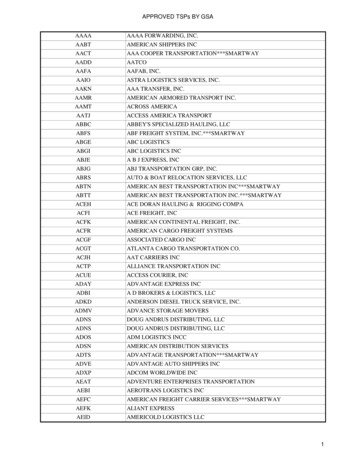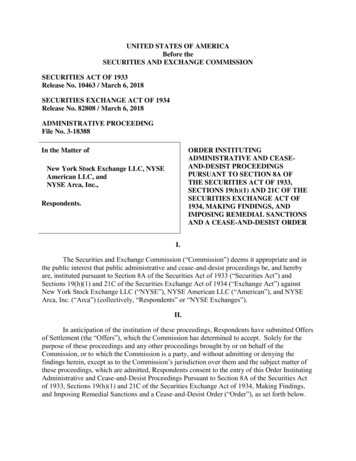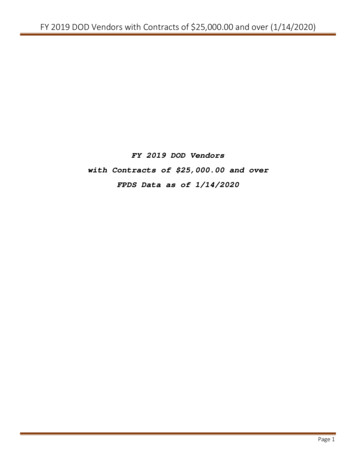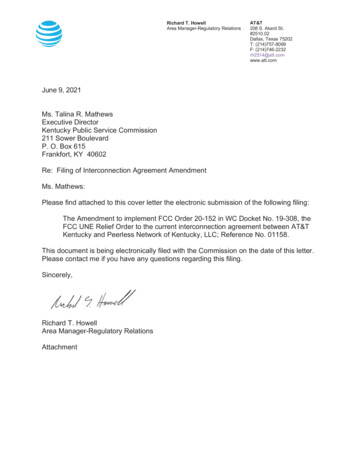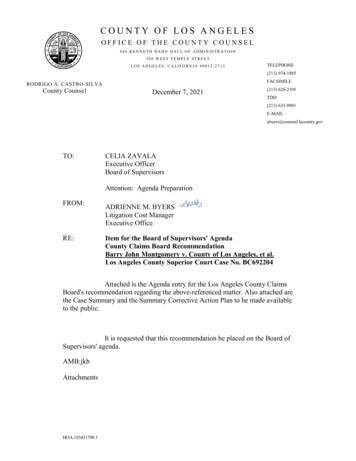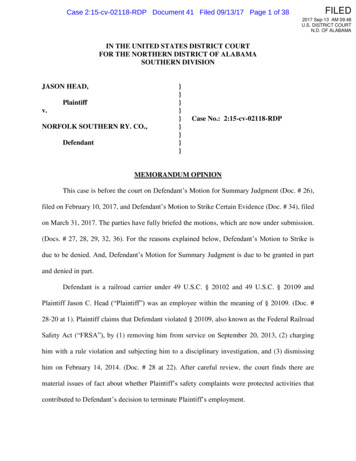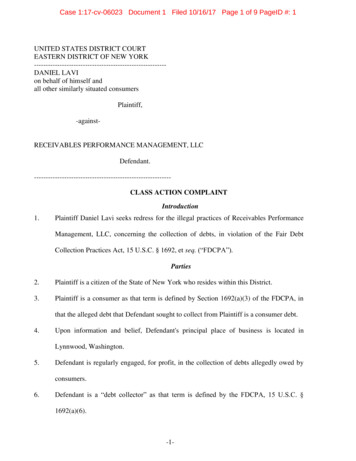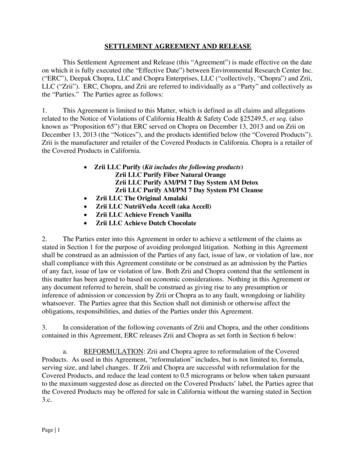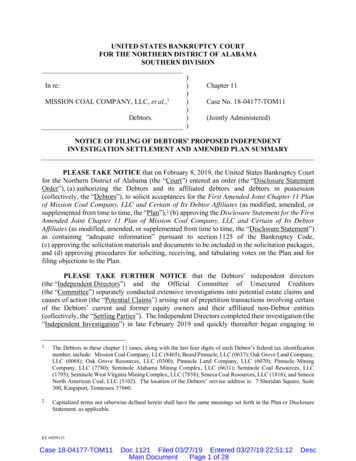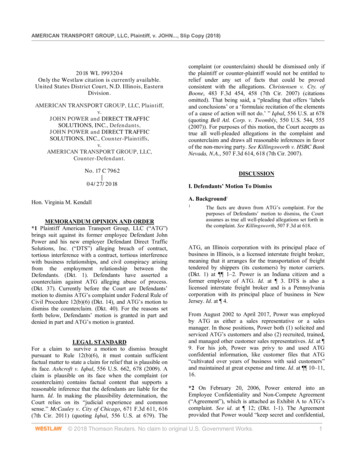
Transcription
AMERICAN TRANSPORT GROUP, LLC, Plaintiff, v. JOHN., Slip Copy (2018)2018 WL 1993204Only the Westlaw citation is currently available.United States District Court, N.D. Illinois, EasternDivision.AMERICAN TRANSPORT GROUP, LLC, Plaintiff,v.JOHN POWER and DIRECT TRAFFICSOLUTIONS, INC., Defendants,JOHN POWER and DIRECT TRAFFICSOLUTIONS, INC., Counter-Plaintiffs,v.AMERICAN TRANSPORT GROUP, LLC,Counter-Defendant.No. 17 C 7962 04/27/2018Hon. Virginia M. KendallMEMORANDUM OPINION AND ORDER*1 Plaintiff American Transport Group, LLC (“ATG”)brings suit against its former employee Defendant JohnPower and his new employer Defendant Direct TrafficSolutions, Inc. (“DTS”) alleging breach of contract,tortious interference with a contract, tortious interferencewith business relationships, and civil conspiracy arisingfrom the employment relationship between theDefendants. (Dkt. 1). Defendants have asserted acounterclaim against ATG alleging abuse of process.(Dkt. 37). Currently before the Court are Defendants’motion to dismiss ATG’s complaint under Federal Rule ofCivil Procedure 12(b)(6) (Dkt. 14), and ATG’s motion todismiss the counterclaim. (Dkt. 40). For the reasons setforth below, Defendants’ motion is granted in part anddenied in part and ATG’s motion is granted.LEGAL STANDARDFor a claim to survive a motion to dismiss broughtpursuant to Rule 12(b)(6), it must contain sufficientfactual matter to state a claim for relief that is plausible onits face. Ashcroft v. Iqbal, 556 U.S. 662, 678 (2009). Aclaim is plausible on its face when the complaint (orcounterclaim) contains factual content that supports areasonable inference that the defendants are liable for theharm. Id. In making the plausibility determination, theCourt relies on its “judicial experience and commonsense.” McCauley v. City of Chicago, 671 F.3d 611, 616(7th Cir. 2011) (quoting Iqbal, 556 U.S. at 679). Thecomplaint (or counterclaim) should be dismissed only ifthe plaintiff or counter-plaintiff would not be entitled torelief under any set of facts that could be provedconsistent with the allegations. Christensen v. Cty. ofBoone, 483 F.3d 454, 458 (7th Cir. 2007) (citationsomitted). That being said, a “pleading that offers ‘labelsand conclusions’ or a ‘formulaic recitation of the elementsof a cause of action will not do.’ ” Iqbal, 556 U.S. at 678(quoting Bell Atl. Corp. v. Twombly, 550 U.S. 544, 555(2007)). For purposes of this motion, the Court accepts astrue all well-pleaded allegations in the complaint andcounterclaim and draws all reasonable inferences in favorof the non-moving party. See Killingsworth v. HSBC BankNevada, N.A., 507 F.3d 614, 618 (7th Cir. 2007).DISCUSSIONI. Defendants’ Motion To DismissA. Background11The facts are drawn from ATG’s complaint. For thepurposes of Defendants’ motion to dismiss, the Courtassumes as true all well-pleaded allegations set forth inthe complaint. See Killingsworth, 507 F.3d at 618.ATG, an Illinois corporation with its principal place ofbusiness in Illinois, is a licensed interstate freight broker,meaning that it arranges for the transportation of freighttendered by shippers (its customers) by motor carriers.(Dkt. 1) at ¶¶ 1–2. Power is an Indiana citizen and aformer employee of ATG. Id. at ¶ 3. DTS is also alicensed interstate freight broker and is a Pennsylvaniacorporation with its principal place of business in NewJersey. Id. at ¶ 4.From August 2002 to April 2017, Power was employedby ATG as either a sales representative or a salesmanager. In those positions, Power both (1) solicited andserviced ATG’s customers and also (2) recruited, trained,and managed other customer sales representatives. Id. at ¶9. For his job, Power was privy to and used ATGconfidential information, like customer files that ATG“cultivated over years of business with said customers”and maintained at great expense and time. Id. at ¶¶ 10–11,16.*2 On February 20, 2006, Power entered into anEmployee Confidentiality and Non-Compete Agreement(“Agreement”), which is attached as Exhibit A to ATG’scomplaint. See id. at ¶ 12; (Dkt. 1-1). The Agreementprovided that Power would “keep secret and confidential, 2018 Thomson Reuters. No claim to original U.S. Government Works.1
AMERICAN TRANSPORT GROUP, LLC, Plaintiff, v. JOHN., Slip Copy (2018)and not use, copy or assist any other person or firm in theuse, disclosure or copying of any of ATG’s confidentialinformation” both during and after his term ofemployment with ATG. (Dkt. 1-1) at 1. With regard tonon-competition and non-solicitation, the Agreementprovided:Editor’s Note: Tabular or graphical material notdisplayable at this time.Id. In other words, Power agreed to a non-competeprovision that prohibited him, during his employmentwith ATG and for three months following his termination,from directly or indirectly working at, having a financialinterest in, being connected or affiliated with, or renderingadvice or services to “any business similar to that of ATGor that of a freight broker.” (Dkt. 1) at ¶ 15. Theremainder of the paragraph contains a non-solicitationprovision, whereby Power agreed to not directly orindirectly divert or solicit any customer or carrier of ATG.Id. at ¶ 14. In between the non-compete clause and thenon-solicitation clause is a handwritten modificationreading “[a]lso for a one year period followingtermination of employment.” See (Dkt. 1-1). ATG allegesthat all of the handwritten modifications were added byPower and that the one-year handwritten addition appliesto the non-solicitation clause. (Dkt. 1) at ¶¶ 12, 14.While Power was employed by ATG, DTS, one of ATG’scompetitors, contacted him and offered him employmentand compensation; DTS did this to get access to ATG’sconfidential customer files. Id. at ¶ 29. On April 13, 2017,Power’s employment was “voluntarily terminated” andATG immediately began experiencing a drop in businessfrom Power’s customers. Id. at ¶¶ 17–18. ATG allegesPower downloaded and disclosed confidential ATGcustomer information to DTS in violation of hisAgreement. Less than three months after Power’stermination, he formally took up employment with DTS.Id. at ¶¶ 17, 19–20. Further, Power solicited or diverted atleast three of ATG’s customers to DTS while he was stillemployed by ATG and he also used the confidentialinformation while working for DTS to take othercustomers away from ATG. Id. at ¶¶ 19, 21. ATG claimsto have lost 800,000 in revenue on account of Power’sactions. Id. at ¶ 22.In November 2017, ATG filed a four-count complaintalleging: breach of the Agreement’s confidentiality,non-compete, and non-solicitation provisions by Power(Count I); tortious interference with Power’s Agreement’sconfidentiality, non-competition, and non-solicitationprovisions by DTS (Count II); tortious interference withATG’s business relationships by Power and DTS (CountIII); and civil conspiracy (Count IV). (Dkt. 1). ATG seeksinjunctive relief, an accounting of all customers“disclosed, solicited and diverted from ATG” to DTS,compensatory damages, and punitive damages of 1.6million. Defendants have moved to dismiss ATG’scomplaint.B. Breach of Contract Against Power (Count I)ATG’s breach of contract claim asserts three restrictivecovenants in Power’s Agreement:a confidentiality provision, a non-competition provision,and a non-solicitation provision. Under Illinois law,which is the governing law selected by the Agreementand which the parties appear to agree applies to theirclaims, a post-employment restrictive covenant isenforceable if it was ancillary to a valid employmentrelationship and contains a reasonable restraint. ReliableFire Equip. Co. v. Arrendondo, 2011 IL 111871, at ¶¶16–17. There is no dispute here that Power entered into arestrictive covenant agreement during his employmentwith ATG or that the restrictive covenants were ancillaryto a valid employment relationship, since Power workedfor ATG for nearly eleven years after signing hisAgreement. (Dkt. 1) at ¶¶ 12, 17; see also Allied WasteServs. of N.A., LLC v. Tibble, 177 F. Supp. 3d 1103, 1107(N.D. Ill. 2016) (continued employment for two yearsafter executing restrictive covenant constitutes validemployment relationship) (citing cases). Rather,Defendant argues that the restrictive covenants areunenforceable because the Agreement contains terms thatare indefinite and unintelligible and also because therestrictive provisions are not reasonable.*3 For a contract to be valid and enforceable, its termsand provisions must be sufficiently certain and definite toenable a court to determine what the parties agreed to do,and while some nonessential terms may be missing or leftto be agreed upon, the parties’ failure to agree upon anessential term of the contract indicates that mutual assentis lacking and there is no enforceable contract. Rose v.Mavrakis, 343 Ill. App. 3d 1086, 1090–91 (1st Dist.2003); see also Szafranski v. Dunston, 2015 IL App (1st)122975–B, ¶ 67 (to be enforceable, the material terms of acontract must also be definite and certain) (citationomitted). Here, Defendants make no argument that theconfidentiality restriction is indefinite or ambiguous.Instead, they argue that the insertion of the handwrittenphrase—“[a]lso for a one year period followingtermination of employment”—in the fourth paragraph ofthe seven-total-paragraph Agreement, between thenon-competition provision and the non-solicitationprovision is so confusing that all of the Agreement’srestraints cannot be enforced. (Dkt. 15) at 7–8.Specifically, Defendants argue that this clause makes no 2018 Thomson Reuters. No claim to original U.S. Government Works.2
AMERICAN TRANSPORT GROUP, LLC, Plaintiff, v. JOHN., Slip Copy (2018)sense when attached to the non-compete provision thatprecedes it, because it contradicts the three-month timeperiod already contained in that provision. Alternatively,if the handwritten clause is read with the non-solicitationprovision, the provision contains grammatical errors andis “unintelligible” because, in Defendants’ view, either aone-year period or a three-month restrictive period couldapply. Id. But ATG alleges in its complaint that thedisputed clause applies to the non-solicitation provision,thereby giving it one-year durational term. (Dkt. 1) at ¶14. The Agreement does not contradict this reading.Therefore, at this time, the Court cannot conclude that thedisputed clause either creates confusion that is fatal to anyrestrictive covenant much less as to all restrictivecovenants contained in the Agreement.22Moreover, even if the Court did find that thishandwritten clause inserted enough ambiguity torequire dismissal of any allegations based on either thenon-competition clause or non-solicitation clause,ATG’s claim for breach of contract based on thealleged breach of the confidentiality provision of theAgreement would still stand.Lincoln Park Sav. Bank v. Binetti, 2011 WL 249461(N.D. Ill. Jan. 26, 2011), cited by Defendants, isdistinguishable. (Dkt. 15) at 6–7. In Binetti, thenon-competition agreement stated only that formeremployees would “comply with a 1–year non-competeagreement if the Mortgage Loan Officer terminatesemployment with Lincoln Park Savings Bankvoluntarily.” 2011 WL 249461, at *4. In spite of thislanguage, Lincoln Park Savings Bank offered a moreprecise interpretation of the non-complete clause in itscomplaint and offered a different explanation of theclause in its motion to dismiss briefing—and neitherexplanation was supported by the contract language.Because of this confusion on the part of the bank, thecourt held that the bank failed to state a claim for breachof contract. In contrast, ATG has not created similarconfusion: it has consistently interpreted thenon-solicitation provision of the agreement to contain thehandwritten one-year post-termination term, and theAgreement does not contradict that reading. Moreover, inBinetti, the court did not find that breach of contract claimfailed because the contract at issue was indefinite andtherefore unenforceable. Instead, on the enforceabilitypoint, the court stated in dicta that it “appears unlikelythat such an undefined restrictive covenant can beenforced. Binetti, 2011 WL 249461, at *4. Accordingly,Binetti does not affect the result here.The same is true for Unisource Worldwide, Inc. v.Carrara, 244 F. Supp. 2d 977 (C.D. Ill. 2003), because ofdifferent problems with the non-competition clause atissue there (and ignoring, for purposes of this discussion,the different procedural posture of that case). (Dkt. 15) at7–8. The non-competition agreement in that casecontained a fragment of a sentence without anytransitional language that literally contradicted thesentence that preceded it. Unisource Worldwide, 244 F.Supp. 2d at 982. On the basis of this language, the courtcould not decipher the terms to which the parties hadagreed, and therefore concluded that the contract was notenforceable. The disputed handwritten modification inthis case does not create the same confusion. Poweragreed to the restrictive covenants and nothing in thehandwritten modification literally contradicts anything inthe non-solicitation provision. At its worst, thehandwritten modification creates confusion as to theduration of the non-solicitation clause: three months orone year? Again, ATG alleges that the term endures forone year, and drawing all inferences in ATG’s favor atthis point, the clause is sufficiently clear to withstand afacial challenge to its validity and to allow ATG toproceed to discovery.*4 Defendants next argue that the Agreement isunenforceable and the breach-of-contract claim should bedismissed because the non-competition provision isgeographically unlimited and the non-solicitationprovision is unlimited in scope. (Dkt. 15) at 9–10. UnderIllinois law, covenants not to compete are disfavored andheld to a high standard. See, e.g., Medix StaffingSolutions, Inc., v. Daniel Dumrauf, 2018 WL 1859039, at*2 (N.D. Ill. Apr. 17, 2018) (citing Cambridge Eng’g, Inc.v. Mercury Partners 90 BI, Inc., 378 Ill. App. 3d 437, 447(1st Dist. 2007)). Although an employer faces a heavyburden to ultimately prevail, courts will only find suchcovenants facially invalid in “extreme cases.”Abbott-Interfast Corp. v. Harkabus, 250 Ill. App. 3d 13,21 (2d Dist. 1993). “[U]nless the covenant is patentlyunreasonable, the parties must be given a full opportunityto develop the necessary evidentiary record.” Allied WasteServs., 177 F. Supp. 3d at 1110.Illinois law requires consideration of three factors todetermine whether a restrictive covenant contains areasonable restraint: (1) whether the restraint is greaterthan required to protect a legitimate business interest ofthe employer-promisee, (2) whether it imposes an unduehardship on the employee-promisor, and (3) whether itposes an injury to the public. Reliable Fire, 2011 IL111871, at ¶ 17. The first of these factors, in turn, is“based on the totality of the facts and circumstances of theindividual case,” including without limitation “thenear-permanence of customer relationships, the 2018 Thomson Reuters. No claim to original U.S. Government Works.3
AMERICAN TRANSPORT GROUP, LLC, Plaintiff, v. JOHN., Slip Copy (2018)employee’s acquisition of confidential informationthrough his employment, and time and place restrictions.”Id. at ¶ 43. None of these subsidiary factors “carries anymore weight than any other,” rather, the importance ofeach is fact dependent. Id. Because Defendants do notraise arguments regarding the other factors pertinent toassessing the clauses’ reasonableness, the Court willaddress only the geographic and activity restrictions.Regarding the non-competition clause’s breadth, the lackof a geographic limitation is not per se unreasonable.Eichmann v. Nat’l Hosp. & Health Care Servs., Inc., 308Ill. App. 3d 337, 344 (1st Dist. 1999); see also Lawrence& Allen, Inc. v. Cambridge Human Res. Grp., Inc., 292Ill. App. 3d 131, 139 (2d Dist. 1997). “Generally, courtswill uphold a restriction on competition that iscoextensive with the area where the promisee is doingbusiness.” Liautaud v. Liautaud, 221 F.3d 981, 988 (7thCir. 2000) (citing Lawrence & Allen, Inc., 292 Ill. App.3d 131). Here, ATG alleges that the clauses’ geographicscope, which includes no limitation, is necessary becauseATG’s business involves the transportation of freightacross the entire United States. See (Dkt. 24) at 7–8. Inaddition, ATG argues that the fluid nature of its businessmeans that the exact geographic location of the broker isirrelevant to the ability of the broker to perform itsservices, and therefore a geographic restriction would beconfusing and difficult to enforce. Id. at 8. Lawrence &Allen, Inc.—cited by Defendants—presented a differentsituation. The non-competition clause in that caseprevented the plaintiff’s former employee from competingwith plaintiff in virtually any capacity in the entirecorporate employee outplacement industry in the UnitedStates. But the plaintiff’s office was located in Naperville,Illinois, and the court could find no other evidence in thesummary judgment record that plaintiff’s clients werelocated nationwide. 292 Ill. App. 3d. at 139. Viewing allof these facts, the court there found the geographicbreadth of the clause to be unreasonable. The Courtreaches a different result here. Taking all reasonableinferences in ATG’s favor, the Court cannot find easonable as a matter of law at this stage, particularlyin light of ATG’s assertions about its business and therelatively short duration of the clause.*5 Looking next at the non-solicitation clause’s activityrestrictions, Illinois courts are “hesitant to enforcenoncompetition agreements that prohibit employees fromsoliciting or servicing not only customers with whom theyhad direct contact, but also customers they never solicitedor had contact with while employed.” Eichmann, 308 Ill.App. 3d at 345. “Courts uphold only thosenoncompetition agreements which protect the employer’slegitimate proprietary interests and not those whose effectis to prevent competition per se.” Id. (citation andquotation omitted). Still, the Court’s assessment of theemployer’s legitimate business interest in instituting therestrictions in the manner in which it did involves amultifactor test of reasonableness: “whether a legitimatebusiness interest exists is based on the totality of the factsand circumstances of the individual case.” Reliable Fire,2011 IL 111871, ¶ 43.Based on the law as set forth by the Illinois SupremeCourt in Reliable Fire, a non-solicitation provision’s lackof limitations on the customers to which it applies doesnot render it per se unreasonable. Traffic Tech, Inc. v.Kreiter, 2015 WL 9259544, at *6 (N.D. Ill. Dec. 18,2015). Indeed, despite the alleged shortcoming in theAgreement, ATG argues that the non-solicitationprovision is reasonable because (1) it is limited to oneyear after termination, (2) it is limited to customers andcarriers of ATG. (Dkt. 24) at 10. With regard to that lastpiece, ATG argues that the customer limitation should beread in context with the entire Agreement and, whendoing so, only applies to ATG customers and carriers thatPower, “with the assistance of ATG.will develop,acquire and use”—language from the confidentialityrestriction. Id. But ATG’s interpretation of thenon-solicitation clause in this way is not supported by theAgreement. As written, it applies to all of ATG’scustomers and carriers, not just those that Power serviced.In any event, even as broadly written, the reasonablenessof this provision depends on the specific facts andcircumstances of this individual case—facts that still mustbe developed, such as, the number of customers orcarriers of ATG and the number within that group withwhom Powers worked. Because the non-solicitationclause in Power’s Agreement is not categoricallyunreasonable as a matter of law, Traffic Tech, Inc., 2015WL 9259544, at *7, Defendants’ arguments that theAgreement is unenforceable are insufficient to defeatATG’s claim at this stage.C. Tortious Interference with a Contract Against DTS(Count II)Defendants’ motion to dismiss Count II of the complaintrelies entirely upon same enforceability argumentsregarding the Agreement that they raised with respect toCount I. Because the Agreement is not fatallyunintelligible and the restrictive covenants in theAgreement are not patently overbroad at this stage of theproceedings, the tortious interference claim will not bedismissed for the same reasons set forth above. 2018 Thomson Reuters. No claim to original U.S. Government Works.4
AMERICAN TRANSPORT GROUP, LLC, Plaintiff, v. JOHN., Slip Copy (2018)D. Tortious Interference with Business RelationshipsAgainst Power and DTS (Count III)Defendants make no explicit argument regarding ATG’stortious interference with business relationships claimagainst them, but instead seek dismissal of the entirecomplaint on their contract-enforceability arguments. See(Dkt. 15) at 6–10. Again, to the extent that this claiminvolves the Agreement and Defendants are relying ontheir arguments regarding the enforceability of theAgreement, this claim survives dismissal for the reasonsset forth above. And to the extent that this claim does notinvolve the Agreement, it also survives dismissal becauseDefendants do not raise any non-Agreement-relatedarguments.relationships. See (Dkt. 1) at ¶¶ 41–42; see also id. at ¶ 43(alleging the following overt acts: “the disclosure and useof confidential and proprietary ATG information,competing against ATG within three months oftermination and soliciting established ATG customerswithin the past year”). As is evident, the same underlyingstate law torts—tortious interference with a contract andtortious interference with business relationships—are thebasis for the state law civil conspiracy claim. That is,ATG fails to set forth facts not already presented inCounts II and III nor does it seek to extend liability toadditional defendants. Thus, the state law civil conspiracyclaim is duplicative and not actionable as a separateclaim.E. Civil Conspiracy (Count IV)ATG also asserts a civil conspiracy claim. “Under Illinoistort law, a civil conspiracy requires ‘(1) an agreementbetween two or more persons for the purpose ofaccomplishing either an unlawful purpose or a lawfulpurpose by unlawful means; and (2) at least one tortiousact by one of the co-conspirators in furtherance of theagreement that caused an injury to the plaintiff.’ ” Turnerv. Hirschbach Motor Lines, 854 F.3d 926, 930 (7th Cir.2017) (citation omitted); see also Adcock v. Brakegate,Ltd., 164 Ill. 2d 54, 63 (1994) (“A cause of action for civilconspiracy exists only if one of the parties to theagreement commits some act in furtherance of theagreement, which is itself a tort.”). However, a“conspiracy claim alleging a tort as the underlyingwrongful act is duplicative where the underlying tort hasbeen pled.” Thermodyne Food Serv. Prods., Inc. v.McDonald’s Corp., 940 F. Supp. 1300, 1310 (N.D. Ill.1996); see LoggerHead Tools, LLC v. Sears HoldingCorp., 19 F. Supp. 3d 775, 784 (N.D. Ill. 2013)(“Additionally, to the extent the underlying tort of thealleged civil conspiracy, fraud, is already alleged by [theplaintiff], the civil conspiracy claim is renderedduplicative.”). More specifically, “because a successfulconspiracy claim enables a plaintiff to holdco-conspirators jointly liable for actions by othermembers of the conspiracy, a conspiracy claim is onlyactionable if it is based on new facts or seeks to extendliability for the underlying tort to new defendants.”Doctor’s Data, Inc. v. Barrett, 170 F. Supp. 3d 1087,1159 (N.D. Ill. 2016) (internal citations omitted); accordReal Colors, Inc. v. Patel, 974 F. Supp. 645, 651 (N.D.Ill. 1997)F. Punitive DamagesDefendants also request dismissal of ATG’s request forpunitive damages on Counts II, III, and IV. (Dkt. 15) at12–13. But these punitive damages requests are notseparate claims; they are parts of claims. And the Courtdoes not have power to dismiss parts of claims on a Rule12(b)(6) motion to dismiss. BBL, Inc. v. City of Angola,809 F.3d 317, 325 (7th Cir. 2015) (“A motion to dismissunder Rule 12(b)(6) doesn’t permit piecemeal dismissalsof parts of claims; the question at this stage is simplywhether the complaint includes factual allegations thatstate a plausible claim for relief.”). None of the state courtcases cited by Defendants support dismissal of onlypieces of the claims at this early stage. As a final pointhere, even construing Defendants’ request as a FederalRule of Civil Procedure 12(f) motion to strike the requestsfor punitive damages (which is the appropriate vehicle forsuch a request), the requests stand at this time. SeeCampbell v. City of Johnston City, 2005 WL 3440726, at*1 (S.D. Ill. Dec. 14, 2005) (finding that request to strikepunitive damages falls under Rule 12(f)). Whetherpunitive damages can be awarded for a particular cause ofaction is a question of law, but whether a defendant’sconduct was sufficiently willful or wanton to justify theimposition of punitive damages is a fact question the forthe jury to decide. Medow v. Flavin, 336 Ill. App. 3d 20,35 (1st Dist. 2002). Construing ATG’s allegations as trueand taking all reasonable inferences in its favor, it hassufficiently alleged that DTS intentionally induced Powerto breach the Agreement and that both rrelationships. It may become evident in the course of theproceedings that punitive damages are not recoverable,but at this stage in the litigation, the requests remain.*6 Here, ATG’s allegations are essentially conspiracy citation clauses in Power’s Agreement andconspiracy to damage ATG’s business and customerII. ATG’s Motion to Dismiss 2018 Thomson Reuters. No claim to original U.S. Government Works.5
AMERICAN TRANSPORT GROUP, LLC, Plaintiff, v. JOHN., Slip Copy (2018)A. Background33The facts are drawn from Defendants’ counterclaim.For the purposes of ATG’s motion to dismiss, the Courtassumes as true all well-pleaded allegations set forth inthe counterclaim. See Killingsworth, 507 F.3d at 618.In response to ATG’s complaint, Power and DTS havefiled a one-count counterclaim for abuse of process. (Dkt.37). In particular, Defendants allege that in February2006, ATG’s CEO, Harold Gross, began requiring allcurrent employees to sign restraint agreements. Powerinitially did not want to sign an agreement, but Grossinsisted, and they agreed to “modify the printed version ofthe restraint, which called for a non-compete,non-solicitation period after termination of one year.” Id.at ¶¶ 11–13. Accordingly, Power “crossed out the oneyear period for the restraint and wrote in the words ‘3months’ ” and he initialed the change and signed theAgreement. Id. at ¶ 15. But Defendants allege that was theonly modification to the Agreement that was written orapproved by Power and that any further modificationswere added after Power signed the agreement anddelivered it to ATG. Id. at ¶¶ 20–21. Specifically,Defendants claim that Power never saw Gross execute theAgreement nor was he given a copy of the fully executedagreement for his records. Instead, the first time he saw afully executed version was when counsel for ATGenclosed a copy of the Agreement in correspondence thatPower received in October 2017. Id. at ¶¶ 18–19.Accordingly, Defendants assert that ATG “purposely andintentionally altered” the Agreement after Power signed itby adding the “[a]lso for a one year period followingtermination of employment” language between thenon-compete clause and the non-solicitation clause. Id. at¶ 23. Therefore, Defendants argue that ATG “wrongfullyinvoke[d] the coercive power of this Court to bar Powerfrom ‘solicitation’ for one year[,] impair legitimatebusiness competition between the parties,” and“intimidate and send a message to ATG’s employees andcompetitors that it takes restrictive covenants seriouslybased on a handwritten modification added to the allegedrestraint agreement after Power executed it.” Id. at ¶¶26–27 (emphasis in original). Defendants argue that ATGhas “wrongfully compelled” them to “litigate non-existentclaims.” Id. at ¶ 28. In briefing this issue, Defendantsfurther argue that ATG relied on the modifiednon-solicitation clause in alleging damages that meet thejurisdictional threshold for diversity jurisdiction. (Dkt. 46)at 4. ATG has moved to dismiss the counterclaim, arguingthat Illinois law does not recognize tort actions based on aparty’s filing of a lawsuit to enforce its contractual rights.(Dkt. 40).B. Abuse of Process*7 Under Illinois law, abuse of process is the misuse oflegal process to accomplish some purpose outside thescope of the process itself, that is, to accomplish apurpose for which it was not designed. See West v. West,694 F.3d 904, 906 (7th Cir. 2012); Bonney v. King, 201Ill. 47, 50–51 (1903). The two distinct elements of anabuse of process claim are: (1) the existence of an ulteriorpurpose or motive, and (2) some act in the use of processthat is not proper in the regular course of proceedings.Neurosurgery & Spine Surgery, S.C. v. Goldman, 339 Ill.App. 3d 177, 182–83 (2d Dist. 2003) (citing HolidayMagic, Inc. v. Scott, 4 Ill. App. 3d 962, 966 (1st Dist.1972)); see also Kumar v. Bornstein, 354 Ill. App. 3d 159,165–66 (2d Dist. 2004). For the first element, a claimantmust plead facts that show that the defendant institutedproceedings against it for an improper purpose, such asextortion, intimidation, or embarrassment. Kumar, 354 Ill.App. 3d at 165. In order to satisfy the second element, theplaintiff must plead facts that show a misapplication ofprocess, or, in other words, the plaintiff must show thatthe process was used to accomplish some result that isbeyond the purview of the process. Id. at 166. The tort ofabuse of process is not favored under Illinois law, andtherefore the elements must be strictly construed.Neurosurgery, 339 Ill
AMERICAN TRANSPORT GROUP, LLC, Counter-Defendant. No. 17 C 7962 04/27/2018 Hon. Virginia M. Kendall MEMORANDUM OPINION AND ORDER *1 Plaintiff American Transport Group, LLC ("ATG") brings suit against its former employee Defendant John Power and his new employer Defendant Direct Traffic Solutions, Inc. ("DTS") alleging breach of contract,

